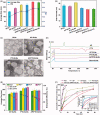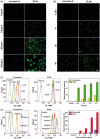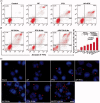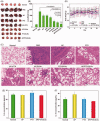Ascorbyl palmitate-incorporated paclitaxel-loaded composite nanoparticles for synergistic anti-tumoral therapy
- PMID: 28856937
- PMCID: PMC8241186
- DOI: 10.1080/10717544.2017.1370619
Ascorbyl palmitate-incorporated paclitaxel-loaded composite nanoparticles for synergistic anti-tumoral therapy
Abstract
A co-loaded drug delivery system based on ascorbyl palmitate that can transport various functional drugs to their targets within a tumor represents an attractive strategy for increasing the efficiency of anticancer treatment. In this study, we developed a dual drug delivery system to encapsulate ascorbyl palmitate (AP) and paclitaxel (PTX) for synergistic cancer therapy. AP, which is a vitamin C derivative, and PTX were incorporated into solid lipid nanoparticles (AP/PTX-SLNs), which were used to treat murine B16F10 melanoma that had metastasized to the lungs of mice. These nanoparticles were spherical with an average size of 223 nm as measured by transmission electron microscope and dynamic light scattering. In vitro cytotoxicity assays indicated that the AP/PTX-SLNs with an AP/PTX mass ratio of 2/1 provided the optimal synergistic anticancer efficacy. In vivo, AP/PTX-SLNs were revealed to be much more effective in suppressing tumor growth in B16F10-bearing mice and in eliminating cancer cells in the lungs than single drug (AP or PTX)-loaded SLNs via a synergistic effect through reducing the Bcl-2/Bax ratio. Furthermore, no marked side effects were observed during the treatment with the AP/PTX-SLNs, indicating that the co-delivery system with ascorbyl palmitate holds promising clinical potential in cancer therapy.
Keywords: Vitamin C; ascorbyl palmitate; derivative; paclitaxel; synergistic anticancer efficacy.
Conflict of interest statement
The authors report no conflicts of interest.
Figures






Similar articles
-
Dissolving Microneedles with Spatiotemporally controlled pulsatile release Nanosystem for Synergistic Chemo-photothermal Therapy of Melanoma.Theranostics. 2020 Jul 9;10(18):8179-8196. doi: 10.7150/thno.44194. eCollection 2020. Theranostics. 2020. PMID: 32724465 Free PMC article.
-
Ascorbic Palmitate as a Bifunctional Drug and Nanocarrier of Paclitaxel for Synergistic Anti-Tumor Therapy.J Biomed Nanotechnol. 2018 Sep 1;14(9):1601-1612. doi: 10.1166/jbn.2018.2615. J Biomed Nanotechnol. 2018. PMID: 29958554
-
Dual drugs (microRNA-34a and paclitaxel)-loaded functional solid lipid nanoparticles for synergistic cancer cell suppression.J Control Release. 2014 Nov 28;194:228-37. doi: 10.1016/j.jconrel.2014.09.005. Epub 2014 Sep 16. J Control Release. 2014. PMID: 25220161
-
Lactoferrin-appended solid lipid nanoparticles of paclitaxel for effective management of bronchogenic carcinoma.Drug Deliv. 2015 Feb;22(2):199-205. doi: 10.3109/10717544.2013.877100. Epub 2014 Jan 27. Drug Deliv. 2015. PMID: 24467582
-
Delivery of baicalein and paclitaxel using self-assembled nanoparticles: synergistic antitumor effect in vitro and in vivo.Int J Nanomedicine. 2015 May 22;10:3737-50. doi: 10.2147/IJN.S80297. eCollection 2015. Int J Nanomedicine. 2015. PMID: 26045664 Free PMC article.
Cited by
-
Advances in the Application of Nanomaterials to the Treatment of Melanoma.Pharmaceutics. 2022 Sep 30;14(10):2090. doi: 10.3390/pharmaceutics14102090. Pharmaceutics. 2022. PMID: 36297527 Free PMC article. Review.
-
Dissolving Microneedles with Spatiotemporally controlled pulsatile release Nanosystem for Synergistic Chemo-photothermal Therapy of Melanoma.Theranostics. 2020 Jul 9;10(18):8179-8196. doi: 10.7150/thno.44194. eCollection 2020. Theranostics. 2020. PMID: 32724465 Free PMC article.
-
Lumbrokinase/paclitaxel nanoparticle complex: potential therapeutic applications in bladder cancer.Int J Nanomedicine. 2018 Jun 26;13:3625-3640. doi: 10.2147/IJN.S166438. eCollection 2018. Int J Nanomedicine. 2018. PMID: 29983558 Free PMC article.
-
Solid Lipid Nanoparticles: Multitasking Nano-Carriers for Cancer Treatment.Pharmaceutics. 2023 Mar 3;15(3):831. doi: 10.3390/pharmaceutics15030831. Pharmaceutics. 2023. PMID: 36986692 Free PMC article. Review.
-
Understanding the Therapeutic Potential of Ascorbic Acid in the Battle to Overcome Cancer.Biomolecules. 2021 Jul 31;11(8):1130. doi: 10.3390/biom11081130. Biomolecules. 2021. PMID: 34439796 Free PMC article. Review.
References
-
- Austria R, Semenzato A, Bettero A. (1997). Stability of vitamin C derivatives in solution and topical formulations. J Pharm Biomed Anal 15:795–801. - PubMed
-
- Banks WA, Kastin AJ. (1985). Peptides and the blood-brain barrier: lipophilicity as a predictor of permeability. Brain Res Bull 15:287–92. - PubMed
-
- Cameron E, Campbell A. (1974). The orthomolecular treatment of cancer. II. Clinical trial of high-dose ascorbic acid supplements in advanced human cancer. Chemico-Biol Interact 9:285–315. - PubMed
-
- Cao X, Luo J, Gong T, et al. . (2015). Coencapsulated doxorubicin and bromotetrandrine lipid nanoemulsions in reversing multidrug resistance in breast cancer in vitro and in vivo. Mol Pharm 12:274–86. - PubMed
MeSH terms
Substances
LinkOut - more resources
Full Text Sources
Other Literature Sources
Research Materials
